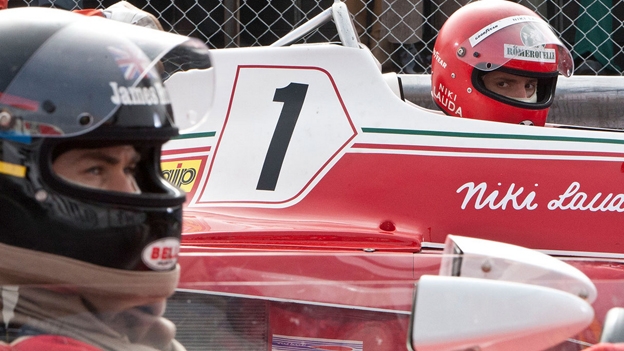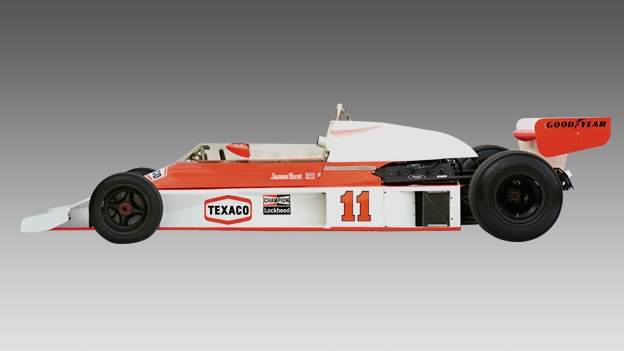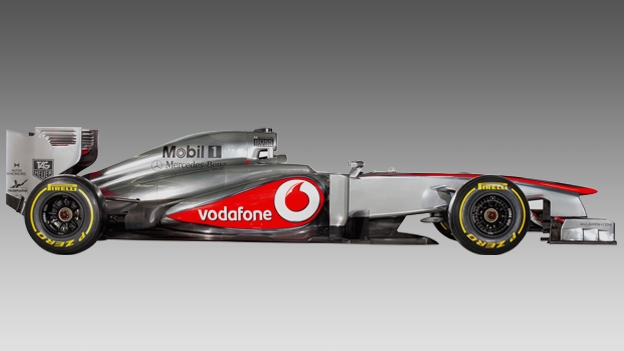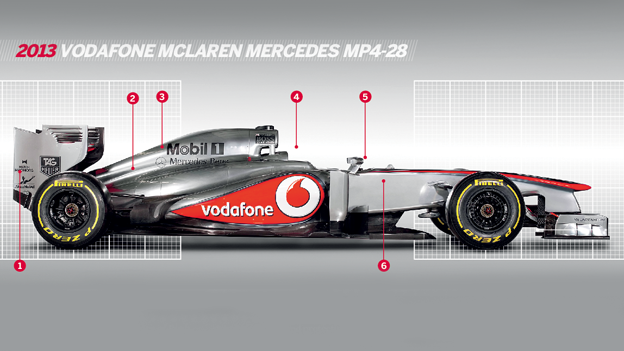T3 investigates the real Rush
As Ron Howard's film is released on DVD, we look at how tech has changed the sport

As Ron Howard's film is released on DVD, we look at the grim reality of F1 in James Hunt's era and how tech has changed the sport
October 6, 1974. Helmuth Koinigg starts 23rd on the grid in the United States Grand Prix. It's only the Austrian's third ever race in Formula 1, and his second ever start. Having won the Formula Vee title the year before, the 25-year-old is a star in the making.
He starts well, but on the tenth lap, on the seventh turn of the 11-corner circuit, a slow puncture means he loses control of his Surtees-Ford.
Koinigg hurtles through two fences and the bottom half of the side barrier; the top half stays in place. Koinigg is decapitated...
This was the grim reality of 1970s Formula 1. Drivers were killed all the time. At the same race the previous year, French driver Francois Cevert hit a guard rail in practice and was cut in half by a barrier. Ian Ashley drove in Koinigg's last race.

“The atmosphere was just completely numb,” he recalls. “But that's just how it was back then. You didn't even consider it. I suppose if you did start thinking about it, it was time to pack it in.” “It was a high-risk business in those days,” agrees Alastair Caldwell, McLaren's team manager from 1971 to 1977. “My brother was killed in a racing car, and then so was Bruce [McLaren], who was a good friend of mine.
After that I didn't want to socialise with racing drivers, because I didn't want to go to their funerals as a friend. I'd rather go as their team manager.” The cars were such death traps that some drivers would keep their seatbelt undone in order to escape a sudden inferno with their life.
Broken ankles
“In the '70s they had aluminium frames, which fractured easily in a crash,” says Ted Kravitz, Sky Sports' F1 pit lane reporter.
“It meant the fuel tank leaked, which is why they had so many fires. They didn't have much foot or leg protection either. Drivers would often break their ankles, or come out with broken legs.” It's not as if '70s engineers were short of technical know-how, they just tended to use it to shave seconds off lap times rather than to add years to drivers' lives.
One of their biggest breakthroughs was ground effects, which made cars stick to the track, helping them corner. In 1976, James Hunt's championship-winning McLaren M23 sat incredibly low to the ground, with a flexible skirt on the outside making air flow around, instead of under, the car. This created more downforce and glued it to the track.
This also made overtaking much trickier; get in the slipstream of the car ahead, and you lose 20 to 30 per cent of your own ground effects, because of the turbulent air from the guy in front. “For the next 30 years we had nose-to-tail racing,” recalls Ashley.
So why was safety an afterthought? “I think some sponsors would be happy to have somebody killed at every race,” says Caldwell. “It just increases the attendance and makes more people watch the telly.”
Get all the latest news, reviews, deals and buying guides on gorgeous tech, home and active products from the T3 experts

Campaigns to make the sport safer fell on deaf ears. Jackie Stewart had long campaigned for greater safety, with the help of the Grand Prix Drivers' Association, the trade union for F1. Before the 1976 German Grand Prix, driver Niki Lauda spearheaded a campaign to boycott the Nürburgring. It failed, and the race went ahead.
Lauda crashed, his car caught fire, and he was left in a coma – a key part of the story of Rush. It wasn't until five years after the crash that McLaren introduced the carbon-fibre chassis, which was less likely to shatter and protected the fuel tank in a crash. It was adopted by all the other teams, as copying is alleged to be so rife that Caldwell dubs it “purple penis” syndrome. “If we put a purple phallus on the front of our car, everyone else would do the same,” he says.
Countless lives were saved, but the sport was still far from safe. The 1994 San Marino Grand Prix saw Roland Ratzenberger and Ayrton Senna lose their lives in the same weekend. The Grand Prix Drivers' Association had been disbanded in 1982, but was reformed, and led the calls for better safety standards.
“It was only after 1994 that they built up the carbon-fibre chassis to protect the shoulders, the neck and the head,” notes Kravitz. In the wake of Senna and Ratzenberger's deaths, F1's governing body the FIA installed black box-style accident data recorders on every car.
No lives lost
The newly formed Expert Advisory Safety Committee introduced numerous safety changes, from collapsible steering columns and protective foam around the top of the cockpit to greater impact testing and making the head and neck support device mandatory for every driver.
The circuits have changed, too, with larger run-off areas and corners with reduced G-force. No lives have been lost in a F1 race since that fateful weekend in '94. Caldwell is in no doubt as to what prompted these advances. “It was because it was a god-like figure like Senna,” he says. “Otherwise nothing would've happened. People would've gone to Ratzenberger's funeral and said 'bad luck'.”
For Ashley, one side effect has been that F1's glamour has faded. “Now it's more about having a very technical car,” he says. “It used to be about racing man to man. Now it's a sort of technical ego-trip.” Others say that's romanticising the past. “Most people involved know that those 'good old days' were absolutely horrific,” reckons Kravitz.
“It's not fun knowing that someone who turned up at a racetrack that morning won't be going home to his family. There's no glamour in that.”
The safety tech that changed F1
THEN: 1976 MCLAREN M23

1. Front Wing
Narrower than previous models, with wider wings it gave more downforce, for tighter cornering. Downforce keeps drivers and their cars right where they need to be, hence the importance of keeping aerodynamics in mind whenever improvements are made today - to keep the cars grounded. Plus they'll go faster, and let's be honest, that's always a winner.
2. Wheelbase
New spacer between engine and gearbox gave better weight distribution and three inches more length. F1 cars are like finely tuned instruments. The slightest change in tuning can have a detrimental effect on performance. A few more inches on the wheelbase may not sound like much, but at breakneck speeds, it all counts.
3. Gearbox
Hewland invented bespoke boxes for racing. Its FG 400, as used here on the 1976 model, and had five forward gears plus a reverse. Pretty standard stuff compared to what lies beneath 2013's cars, but onwards and upwards, as they say…
4. Body
Aluminium monocoque tended to shatter on impact, damaging fuel tank. Result: more fires than today. The introduction of carbon fibre bodies changed that, making Formula 1 a much safer sport.
5. Engine
Ford Cosworth DFV, tuned by specialist super-tinkerers Nicholson Engines, put out around 490bhp. This is nowhere close to what we have today, but cut them some slack, we're looking at cars that were raced almost 30 years ago.
6. Weight
A weight of 168kg made this quite the hulking beast, at least compared to the MP4-28's feather-like 95kg. That's a winner for fuel efficiency, as well as braking.
NOW: 2013 MCLAREN MERCEDES MP4-28

1. Rear Wing
Button-operated DRS (drag reduction system) changes wing angle to reduce drag for slicker overtaking. First introduced in 2011, the DRS opens an adjustable flap on the rear wing of the car to reduce drag, thus giving a pursuing car more speed and thus a greater chance of overtaking a car in front.
2. Body
All made of a moulded lightweight carbon-fibre composite, including engine cover, floor, sidepods, nose and wings. The body is strong, as well as shatter resistant in comparison to the 1976 model. This means less engine fires.
3. Engine
Mercedes-Benz's FO 108F is only a 2.4-litre V8, but tuned to 18,000rpm, giving 750bhp and 0-60 in 2.5 seconds. This makes for an insanely fast car - just how racing should be.
4. Cockpit
The driver's safety is priority numero uno. Survival cell housing driver and fuel cell is padded and surrounded by crushable, protective impact structures. The survival cell's flanks are protected by a 6mm layer of carbon and Zylon – the same stuff that is used to make bullet-proof vests. This housing protects the driver from objects such as carbon fibre splinters.
5. Gearbox
Seamless shift box means less loss of power between gears. Pioneered in 2005, this style of gearbox is now in most high-end cars.
6. KERS
Kinetic Energy Recovery System stores energy during braking, and then unleashes 60KW of it at a button-press, allowing the driver to make the most out of a crucial acceleration.